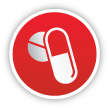Herbal medicines continue to be used by 75–80% of the world’s population for primary health care. They are commonly accepted, especially in traditional societies, and they often have better compatibility with the human body with less side-effects.
Approximately 25% of prescribed drugs contain plant extracts or active ingredients obtained from or modeled on plant substances. These include some of the most utilized drugs such as aspirin, atropine, colchicine, digoxin, ephedrine, morphine, quinine and quinidine, as well as the cancer treating chemicals taxol, vincristine and vinblastine. Most of these plant-derived drugs were originally discovered through the study of traditional cures and folk knowledge.
The resurgence of herbal drug usage in recent years may be attributed to the hazardous side effects of many synthetic drugs. However, doctors often have a jaundiced view of herbal products because they don’t understand their method of action in terms of modern science. They also question the consistency and accuracy of the active ingredient per dose. Standardization, including assessing botanical purity and potency would foster greater acceptance of the herbal products in the Western medical community.
The establishment of “Good manufacturing practice” or GMP guidelines requires manufacturers of herbal supplements to follow clearly defined processes that ensure compliance with specific quality controls. GMPs are enforced by the US FDA and Health Canada. By only purchasing products that have been produced by GMP facilities, consumers can have a certain level of confidence in the quality of the supplements.


